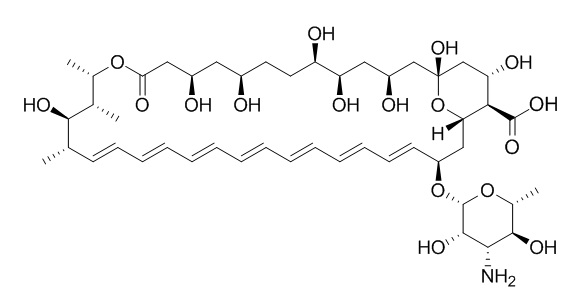Amphotericin B
Amphotericin B is an antifungal agent. Amphotericin B can regulate inflammatory cytokines in host cells and regulate inflammatory responses in HGEC, it inhibits the A. actinomycetemcomitans-induced phosphorylation of ERK and p38 MAP kinase. Amphotericin B inhibits the A. actinomycetemcomitans-induced production of prostaglandin E2, the inhibition of the PKA signaling pathway can aid in reducing the degree of nephrotoxicity caused by Amphotericin B. Treatment with amphotericin B, particularly in combination with MCSF, increased the number of oligodendrocyte precursor cells and promoted remyelination within lesions.
Inquire / Order:
manager@chemfaces.com
Technical Inquiries:
service@chemfaces.com
Tel:
+86-27-84237783
Fax:
+86-27-84254680
Address:
1 Building, No. 83, CheCheng Rd., Wuhan Economic and Technological Development Zone, Wuhan, Hubei 430056, PRC
Providing storage is as stated on the product vial and the vial is kept tightly sealed, the product can be stored for up to
24 months(2-8C).
Wherever possible, you should prepare and use solutions on the same day. However, if you need to make up stock solutions in advance, we recommend that you store the solution as aliquots in tightly sealed vials at -20C. Generally, these will be useable for up to two weeks. Before use, and prior to opening the vial we recommend that you allow your product to equilibrate to room temperature for at least 1 hour.
Need more advice on solubility, usage and handling? Please email to: service@chemfaces.com
The packaging of the product may have turned upside down during transportation, resulting in the natural compounds adhering to the neck or cap of the vial. take the vial out of its packaging and gently shake to let the compounds fall to the bottom of the vial. for liquid products, centrifuge at 200-500 RPM to gather the liquid at the bottom of the vial. try to avoid loss or contamination during handling.
Phytomedicine.2019, 56:48-56
Toxicol Appl Pharmacol.2022, 434:115815.
Pest Manag Sci.2019, 75(9):2530-2541
Oncotarget.2015, 6(31):30831-49
Int J Oncol.2019, 55(1):320-330
Appl. Sci.2023, 13(17), 9653.
FARMACIA2023, Vol.71,3.
British Jou. Med.&Med. Research2014, 1802-1811
Drug Des Devel Ther.2023, 17:2461-2479.
Chem. of Vegetable Raw Materials2020, 97-105
Related and Featured Products
Cell Immunol. 2014 Aug;290(2):201-8.
Amphotericin B down-regulates Aggregatibacter actinomycetemcomitans-induced production of IL-8 and IL-6 in human gingival epithelial cells.[Pubmed:
25064453]
Gingival epithelium is the primary barrier against microorganism invasion and produces inflammatory cytokines. Amphotericin B, a major antifungal drug, binds to cholesterol in the mammalian cell membrane in addition to fungal ergosterol. Amphotericin B has been shown to regulate inflammatory cytokines in host cells.
METHODS AND RESULTS:
To investigate the suppressive effect of Amphotericin B on the gingival epithelium, we examined the expression of interleukin (IL)-8 and IL-6 and involvement of MAP kinase in human gingival epithelial cells (HGEC) stimulated by Aggregatibacter actinomycetemcomitans. Amphotericin B and the p38 MAP kinase inhibitor down-regulated the A. actinomycetemcomitans-induced increase in the expression of IL-8 and IL-6 at the mRNA. The ERK inhibitor suppressed the A. actinomycetemcomitans-induced IL-8 mRNA expression. Amphotericin B inhibited the A. actinomycetemcomitans-induced phosphorylation of ERK and p38 MAP kinase. Furthermore, Amphotericin B inhibited the A. actinomycetemcomitans-induced production of prostaglandin E2.
CONCLUSIONS:
These results suggest that Amphotericin B regulate inflammatory responses in HGEC.
J Neurosci. 2015 Jan 21;35(3):1136-48.
Stimulation of monocytes, macrophages, and microglia by amphotericin B and macrophage colony-stimulating factor promotes remyelination.[Pubmed:
25609628]
Approaches to stimulate remyelination may lead to recovery from demyelinating injuries and protect axons. One such strategy is the activation of immune cells with clinically used medications, since a properly directed inflammatory response can have healing properties through mechanisms such as the provision of growth factors and the removal of cellular debris. We previously reported that the antifungal medication Amphotericin B is an activator of circulating monocytes, and their tissue-infiltrated counterparts and macrophages, and of microglia within the CNS.
METHODS AND RESULTS:
Here, we describe that Amphotericin B activates these cells through engaging MyD88/TRIF signaling. When mice were subjected to lysolecithin-induced demyelination of the spinal cord, systemic injections of nontoxic doses of Amphotericin B and another activator, macrophage colony-stimulating factor (MCSF), further elevated the representation of microglia/macrophages at the site of injury. Treatment with Amphotericin B, particularly in combination with MCSF, increased the number of oligodendrocyte precursor cells and promoted remyelination within lesions; these pro-regenerative effects were mitigated in mice treated with clodronate liposomes to reduce circulating monocytes and tissue-infiltrated macrophages.
CONCLUSIONS:
Our results have identified candidates among currently used medications as potential therapies for the repair of myelin.
J Appl Toxicol. 2014 Dec;34(12):1285-92.
Alteration in cellular viability, pro-inflammatory cytokines and nitric oxide production in nephrotoxicity generation by Amphotericin B: involvement of PKA pathway signaling.[Pubmed:
24105867]
Amphotericin B is one of the most effective antifungal agents; however, its use is often limited owing to adverse effects, especially nephrotoxicity. The purpose of this study was to evaluate the effect of inhibiting the PKA signaling pathway in nephrotoxicity using Amphotericin B from the assessment of cell viability, pro-inflammatory cytokines and nitric oxide (NO) production in LLC-PK1 and MDCK cell lines.
METHODS AND RESULTS:
Amphotericin B proved to be cytotoxic for both cell lines, as assessed by the mitochondrial enzyme activity (MTT) assay; caused DNA fragmentation, determined by flow cytometry using the propidium iodide (PI) dye; and activated the PKA pathway (western blot assay). In MDCK cells, the inhibition of the PKA signaling pathway (using the H89 inhibitor) caused a significant reduction in DNA fragmentation. In both cells lines the production of interleukin-6 (IL)-6 proved to be a dependent PKA pathway, whereas tumor necrosis factor-alpha (TNF-α) was not influenced by the inhibition of the PKA pathway. The NO production was increased when cells were pre-incubated with H89 followed by Amphotericin B, and this production produced a dependent PKA pathway in LLC-PK1 and MDCK cells lines.
CONCLUSIONS:
Therefore, considering the present study's results as a whole, it can be concluded that the inhibition of the PKA signaling pathway can aid in reducing the degree of nephrotoxicity caused by Amphotericin B.



